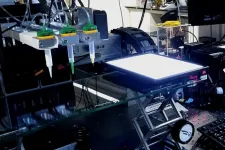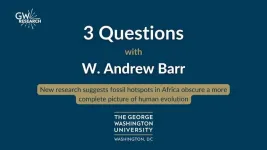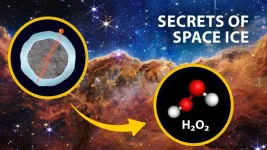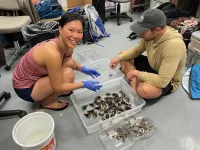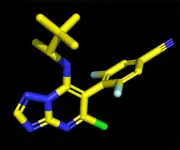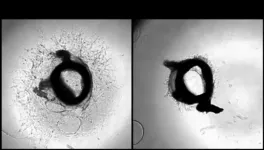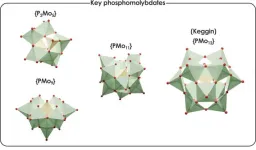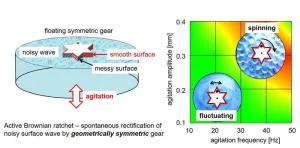(Press-News.org) MINNEAPOLIS / ST. PAUL (08/20/2024) — A first-of-its-kind adaptive 3D printing system developed by University of Minnesota Twin Cities researchers can identify the positions of randomly distributed organisms and safely move them to specific locations for assembly. This autonomous technology will save researchers time and money in bioimaging, cybernetics, cryopreservation, and devices that integrate living organisms.
The research is published in Advanced Science, a peer-reviewed scientific journal. The researchers have a patent pending on the technology.
The system can track, collect, and accurately position bugs and other organisms, whether they are stationary, in droplets, or in motion. The pick-and-place method guided by real-time visual and spatial data adapts and can ensure precise placement of the organisms.
“The printer itself can act like a human would, with the printer acting as hands, the machine vision system as eyes, and the computer as the brain,” said Guebum Han, a former University of Minnesota mechanical engineering postdoctoral researcher and first author on the paper. “The printer can adapt in real-time to moving or still organisms and assemble them in a certain array or pattern.”
Typically, this process has been done manually and takes extensive training, which can lead to inconsistencies in organism-based applications. With this new type of system, the amount of time decreases for researchers and allows for more consistent outcomes.
This technology could increase the number of organisms processed for cryopreservation, sort live organisms from deceased ones, place organisms on curved surfaces, and integrate organisms with materials and devices in customizable shapes. It also could lay the groundwork for creating complex arrangements of organisms, such as superorganism hierarchies—organized structures found in insect colonies like ants and bees. In addition, the research could lead to advances in autonomous biomanufacturing by making it possible to evaluate and assemble organisms.
For example, this system was used to improve cryopreservation methods for zebrafish embryos, which was previously done through manual manipulation. With this new technology, the researchers were able to show that the process could be completed 12 times faster compared to the manual process. Another example showcases how its adaptive strategy tracked, picked up and placed randomly moving beetles, and integrated them with functional devices.
In the future, the researchers hope to continue to advance this technology and combine it with robotics to make it portable for field research. This could allow researchers to collect organisms or samples in areas that would normally be inaccessible.
In addition to Han, the University of Minnesota Department of Mechanical Engineering team included graduate research assistants Kieran Smith and Daniel Wai Hou Ng, Assistant Professor JiYong Lee, Professor John Bischof, Professor Michael McAlpine, and former postdoctoral researchers Kanav Khosla and Xia Ouyang. In addition, the work was in collaboration with the Engineering Research Center (ERC) for Advanced Technologies for the Preservation of Biological Systems (ATP-Bio).
This work was funded by the National Science Foundation, the National Institutes of Health, and Regenerative Medicine Minnesota.
To read the entire research paper titled, “3D Printed Organisms Enabled by Aspiration-Assisted Adaptive Strategies”, visit the Advanced Science website.
END
Adaptive 3D printing system to pick and place bugs and other organisms
First-of-its-kind technology can help accelerate the process of cryopreservation, cybernetics, and bioimaging
2024-08-20
ELSE PRESS RELEASES FROM THIS DATE:
Fossil hotspots in Africa obscure a more complete picture of human evolution
2024-08-20
WASHINGTON (August 20, 2024) – Much of the early human fossil record originates from just a few places in Africa, where favorable geological conditions have preserved a trove of fossils used by scientists to reconstruct the story of human evolution. One of these fossil hotspots is the eastern branch of the East African Rift System, home to important fossil sites such as Oldupai Gorge in Tanzania. Yet, the eastern branch of the rift system only accounts for 1% of the surface area of Africa—a fact that makes it possible to estimate how much information scientists who rely on such small samples are missing.
In ...
Extraterrestrial chemistry with earthbound possibilities
2024-08-20
DENVER, Aug. 20, 2024 — Who are we? Why are we here? As the Crosby, Stills, Nash & Young song suggests, we are stardust, the result of chemistry occurring throughout vast clouds of interstellar gas and dust. To better understand how that chemistry could create prebiotic molecules — the seeds of life on Earth and possibly elsewhere — researchers investigated the role of low-energy electrons created as cosmic radiation traverses through ice particles. Their findings may also inform medical and environmental applications on our home planet.
Undergraduate student Kennedy Barnes will present the team’s results at the fall meeting of the American ...
Deadly sea snail toxin could be key to making better medicines
2024-08-20
Scientists are finding clues for how to treat diabetes and hormone disorders in an unexpected place: a toxin from one of the most venomous animals on the planet.
A multinational research team led by University of Utah scientists has identified a component within the venom of a deadly marine cone snail, the geography cone, that mimics a human hormone called somatostatin, which regulates the levels of blood sugar and various hormones in the body. The hormone-like toxin’s specific, long-lasting effects, which help the snail hunt its prey, could also help scientists design better ...
Planets contain more water than thought
2024-08-20
We know that the Earth has an iron core surrounded by a mantle of silicate bedrock and water (oceans) on its surface. Science has used this simple planet model until today for investigating exoplanets – planets that orbit another star outside our solar system. “It is only in recent years that we have begun to realise that planets are more complex than we had thought,” says Caroline Dorn, Professor for Exoplanets at ETH Zurich.
Most of the exoplanets known today are located close to ...
Blood platelet score detects previously unmeasured risk of heart attack and stroke
2024-08-20
Platelets are circulating cell fragments known to clump up and form blood clots that stop bleeding in injured vessels. Cardiologists have long known that platelets can become “hyperreactive” to cause abnormal clotting that blocks arteries and contributes to heart attack, stroke, and poor blood flow (peripheral artery disease) in the legs of millions of Americans.
Despite this major contribution to cardiovascular risk, routine measurement of whether each patient’s platelets clump (aggregate) too much has been infeasible to date. ...
New international Pioneer Centre for medical data research
2024-08-20
Can research on diseases as diverse as, for example, diabetes, cardiovascular diseases, psychiatric disorders and endometriosis be linked? The answer is yes if the research focuses on collecting and analysing large amounts of data from both Danish and international registers and biobanks to learn more about, among other things, risk factors, relationships, patterns, treatment and consequences.
And this is exactly what a new international Pioneer Centre, The Pioneer Centre for SMARTbiomed (Statistical and Computational Methods for Advanced Research ...
NIH awards $6.9 million to advance potential Alzheimer’s disease treatment
2024-08-20
A multidisciplinary team of scientists led by Carlo Ballatore, Ph.D., at University of California San Diego and Kurt Brunden, Ph.D., at the University of Pennsylvania has been awarded a $6.9 million grant from the National Institute on Aging (NIA) to prepare a potential disease-modifying Alzheimer’s treatment for future clinical trials. In a recently published study about the new compound, called CNDR-51997, the team found it was effective in restoring brain health in mouse models of Alzheimer's disease. CNDR-51997 was identified through a joint drug discovery program at Penn and UC San Diego that was supported by grants from the NIA.
The ...
iSN04: A novel nucleic acid drug for the treatment of vascular diseases
2024-08-20
Atherosclerosis, a major cause of mortality worldwide, involves an overgrowth of vascular smooth muscle cells in the blood vessels, constraining blood flow and potentially causing cardiovascular diseases. Against this backdrop, researchers from Shinshu University recently developed a DNA aptamer called iSN04 that targets and counteracts with the protein nucleolin in smooth muscle cells. This anti-nucleolin aptamer helps maintain smooth muscle cells in a differentiated state, offering new treatment potential for atherosclerosis and other vascular ...
New computational methodology to predict the complex formation of interesting nanostructures
2024-08-20
Researchers from the group of Prof. Carles Bo, at the Institute of Chemical Research of Catalonia (ICIQ-CERCA), have described a computational methodology that simulates complex processes involving different chemical species and diverse conditions. These processes lead to the formation of nanostructures called polyoxometalates (POMs), with important applications in catalysis, energy storage, biology and medicine.
"Our group has recently developed unique methods to study the chemistry of polyoxometalates in solution, their speciation and formation ...
Novel ratchet with geometrically symmetric gear driven by asymmetric surface wettability
2024-08-20
The ratchet mechanism is a fascinating energy-conversion system that converts disorderly or random motion into orderly, directed movement through a process known as spontaneous rectification. It is a critical component of mechanical systems, typically consisting of a gear and a pawl, which restricts the movement of the gear in one direction. In biological systems, the concept of a Brownian ratchet has been proposed to help understand the mechanism of molecular motors, where chemical reactions rectify the random thermal motion of molecules.
According to the second law of thermodynamics, uniform thermal ...
LAST 30 PRESS RELEASES:
Heart-brain connection: international study reveals the role of the vagus nerve in keeping the heart young
Researchers identify Rb1 as a predictive biomarker for a new therapeutic strategy in some breast cancers
Survey reveals ethical gaps slowing AI adoption in pediatric surgery
Stimulant ADHD medications work differently than thought
AI overestimates how smart people are, according to HSE economists
HSE researchers create genome-wide map of quadruplexes
Scientists boost cell "powerhouses" to burn more calories
Automatic label checking: The missing step in making reliable medical AI
Low daily alcohol intake linked to 50% heightened mouth cancer risk in India
American Meteorological Society announces Rick Spinrad as 2026 President-Elect
Biomass-based carbon capture spotlighted in newly released global climate webinar recording
Illuminating invisible nano pollutants: advanced bioimaging tracks the full journey of emerging nanoscale contaminants in living systems
How does age affect recovery from spinal cord injury?
Novel AI tool offers prognosis for patients with head and neck cancer
Fathers’ microplastic exposure tied to their children’s metabolic problems
Research validates laboratory model for studying high-grade serous ovarian cancer
SIR 2026 delivers transformative breakthroughs in minimally invasive medicine to improve patient care
Stem Cell Reports most downloaded papers of 2025 highlight the breadth and impact of stem cell research
Oxford-led study estimates NHS spends around 3% of its primary and secondary care budget on the health impacts of heat and cold in England
A researcher’s long quest leads to a smart composite breakthrough
Urban wild bees act as “microbial sensors” of city health.
New study finds where you live affects recovery after a hip fracture
Forecasting the impact of fully automated vehicle adoption on US road traffic injuries
Alcohol-related hospitalizations from 2016 to 2022
Semaglutide and hospitalizations in patients with obesity and established cardiovascular disease
Researchers ‘listen in’ to embryo-mother interactions during implantation using a culture system replicating the womb lining
How changing your diet could help save the world
How to make AI truly scalable and reliable for real-time traffic assignment?
Beyond fragmented markets: A new framework for efficient and stable ride-pooling
Can shape priors make road perception more reliable for autonomous driving?
[Press-News.org] Adaptive 3D printing system to pick and place bugs and other organismsFirst-of-its-kind technology can help accelerate the process of cryopreservation, cybernetics, and bioimaging
